All issues

Author:Chien-Ming Chou, Chun-Tao Chen, Chin-Hui Tsai, Chin-Chih Chen, and Ting-Chin Deng*
Abstract:
Using of synthetic peptide immunogens to produce antibodies with universal immunogenicity are a useful tool for diagnosis of plant viral diseases. Addition to the coat protein (CP) gene of Tomato mosaic virus (ToMV), we adopted the CP gene containing the predicted epitope sequences of Odontoglossum ringspot virus (ORSV) and Cucumber green mottle mosaic virus (CGMMV) to assemble into a fused polynucleotide. A total of 1,136 bases of synthetic nucleotides were joined covalently and created a recombinant plasmid cloned in the vector of pUC57 in Escherichia coli. The protein containing peptides encoded by the synthetic polynucleotide was expressed by the vector pET-28a. After purification, this expressed protein was used to immunize a New Zealand rabbit for production of a polyclonal antiserum. By Western blot, such an antiserum reacted with corresponding virus was examined for immunological properties and the coverage of antigenic universe. As the antiserum was applied to indirect enzyme-linked immunosorbent assay (ELISA), every tobamovirus tested in this study was detectable by the universal antibodies, but Hibiscus latent Singapore virus (HLSV) was an exception. A single reagent can detect a variety of tobamoviruses simultaneously; therefore, it can be practically applied to quarantine inspection and productions of Solanaceous seeds, Cucurbitaceous seeds, and some ornamental vegetative propagules.
Key words:Virus, Coat portion, Immunogen, Polyclonal antiserum, Western blot
Download:![]() PDF Links
PDF Links
- 1. Development of Tractor-Mounted Seedling Transplanter for Sweet Potato
- 2. Synergistic Effect of Additional Gas on the Toxicity of Phosphine to Sitophilus oryzae and Sitophilus zeamais (Coleoptera: Dryophthoridae)
- 3. Effects of Temperature and Solar Radiation on Growth Traits and Plant Elements in Purple Leafy Sweet Potato
 Submit your manuscript
Submit your manuscript
 Guide for authors
Guide for authors